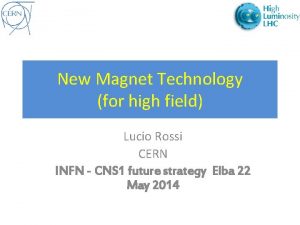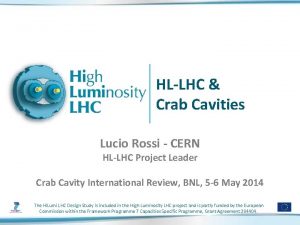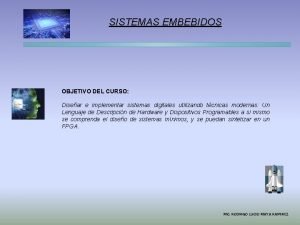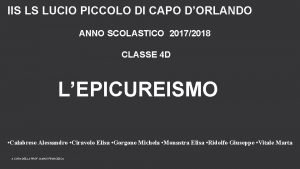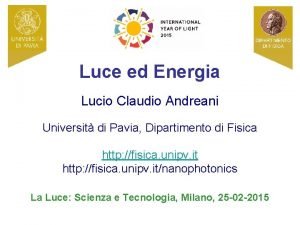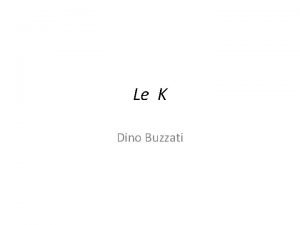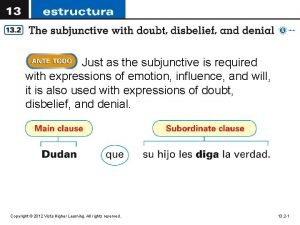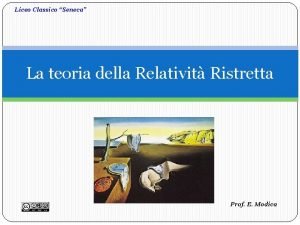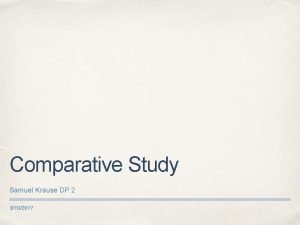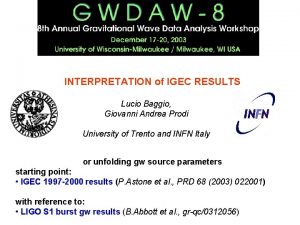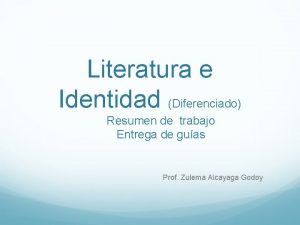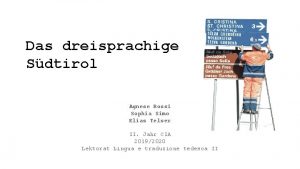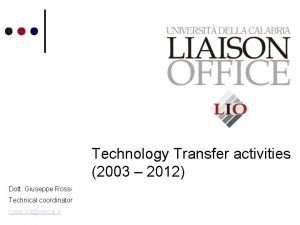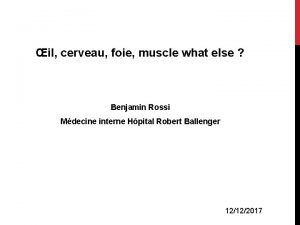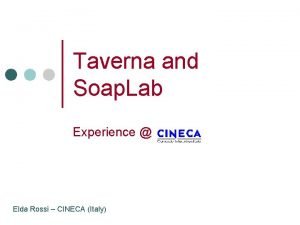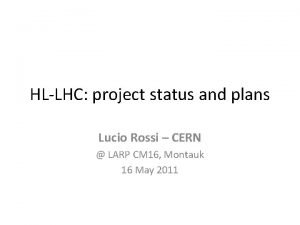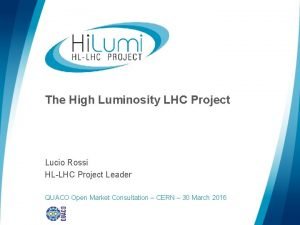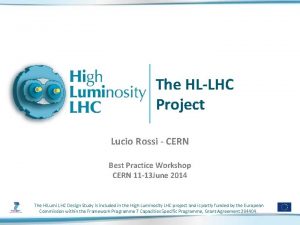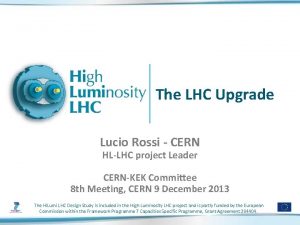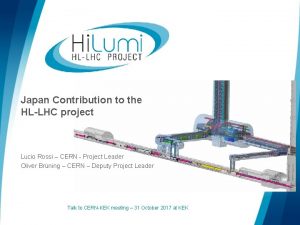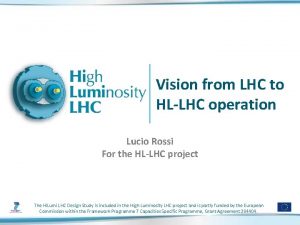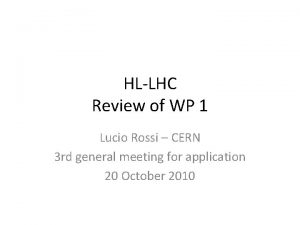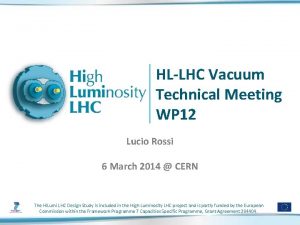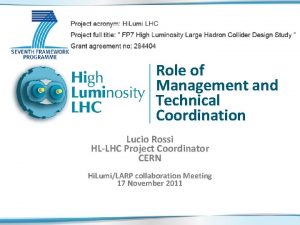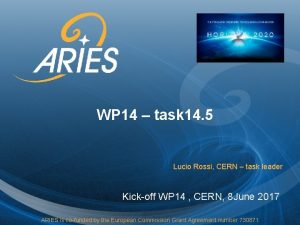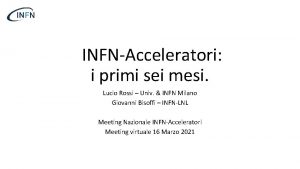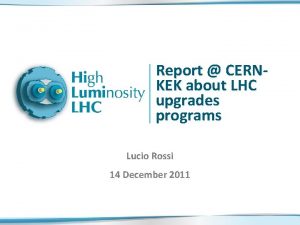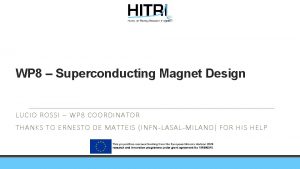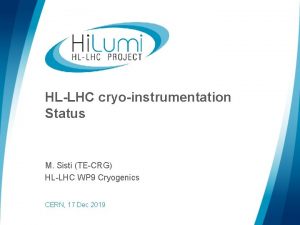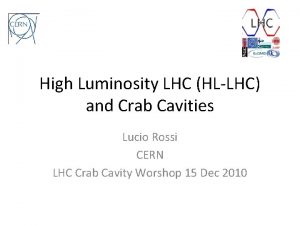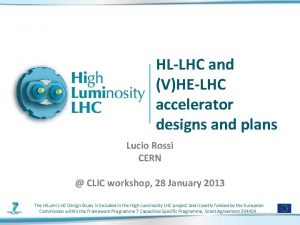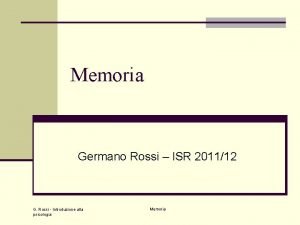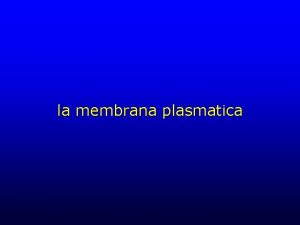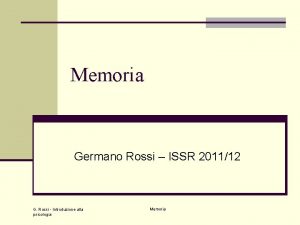HLLHC Project status Lucio Rossi Project Leader 11











![Luminosity performance estimate for the nominal HL-LHC: Llev = 5 1034 Crossing angle [mrad/s] Luminosity performance estimate for the nominal HL-LHC: Llev = 5 1034 Crossing angle [mrad/s]](https://slidetodoc.com/presentation_image_h2/f845c82cb479dab7c5379df1e8f3b6b5/image-12.jpg)













- Slides: 25

HL-LHC Project status Lucio Rossi Project Leader 11 th CERN-KEK Collaboration Committee CERN, 13 December 2016

Goal of High Luminosity LHC (HL-LHC) as fixed in November 2010 From FP 7 Hi. Lumi LHC Design Study application The main objective of Hi. Lumi LHC Design Study is to determine a hardware configuration and a set of beam parameters that will allow the LHC to reach the following targets: A peak luminosity of Lpeak = 5× 1034 cm-2 s-1 with levelling, allowing: An integrated luminosity of 250 fb-1 per year, enabling the goal of Lint = 3000 fb-1 twelve years after the upgrade. This luminosity is more than ten times the luminosity reach of the first 10 years of the LHC lifetime. Ultimate performance established 2015 -2016: withfrom same hardware Concept of ultimate performance discussed 2013: and use Integrated of engineering Lult 7. 5 same 1034 beam cm-2 s-1 parameters: and Ultimate Lint ultmargins: 4000 fb-1 Lpeak ult 7. 5 1034 not cm-2 be s-1 the andlimit, Ultimate Lint ultmore… 4000 fb-1 LHC should would Integrated Physics require LHC should not be the limit, would Physics require more… L Rossi @ CERN-KEK 13 Dec 2016 2

L Rossi @ CERN-KEK 13 Dec 2016 3

Hi. Lumi LHC landmarks L Rossi @ CERN-KEK 13 Dec 2016 4

HL approved in June 2016 CERN Council (left) HL as new ESFRI landmark (right L Rossi @ CERN-KEK 13 Dec 2016 5

Hi. Lumi & Collaborations: the long route Beyond FP 7: CEA, INFN. UK CIEMAT, Uppsala Canada/Triumf? China/IHEP? Russia/BINP? L Rossi @ CERN-KEK 13 Dec 2016 6

Civil engineering underground works at Point 5 Situation in May 2016 L Rossi @ CERN-KEK 13 Dec 2016 7

Rebaselining § End May 2016 internal C&S review of WP 17 § about 120 MCHF extra-cost: part due to extra UG volume and building surface, part due to new cost evaluation § Mandate from CERN management § Stay within the original envelope at same performance… § Method § examination of all WPs in view of the Project main goals § Identification of the all possible savings, with reasonable impact on performance and availability, reducing the levels of redundancy/mitigations § Selection of the safest savings having also the largest impact on T. I. scope reduction. § Keep reversibility (possibility to recovery the missed hardware later on) L Rossi @ CERN-KEK 13 Dec 2016 8

Rebaseline § Crab Cavity: reduction of CC system from 4 to 2 cavities/beam-side 16 CCs + 4 spares (vs. 32+8 previous). Impact on perfomance: visible but not dramatic – see later § Revision of the power/CC and volume of the power conv. § Shifting installation of new MQYY as new Q 4 (90 mm aperture) to after HL-LHC end (i. e. in LS 4), if needed. HL will start using as Q 4 the present 70 mm MQY modified for 1. 9 K operation. § Negligible impact on baseline performance (also because of CC reduction), but more pronounced for flat beams. § QPS for the MQXF maintaining all systems (QHout, Qhinn, (Qhintr), and CLIQ) however with a minimal configuration with redundancy. L Rossi @ CERN-KEK 13 Dec 2016 9

Rebaseline § Reduction of TCLD (DS collimator in P 7 from 4 to 2 per side). This entails no 11 T for LS 3 (while keeping it for LS 2). Reduction of TCTPM from 16+3 to 8+2 § New integration layout for mini. TAN of P 8, more integrated with D 2 § New cryobox lay-out (with external distribution box) § Improved LSS vacuum layout (WP 12) and partial manpower internalization via resource optimization. § Minimal reduction of Beam Diagnostics (WP 13) § Modularity optimization of TCDS (WP 14) § Powering the IPQs (Q 6 -Q 5 -Q 4) from the RR, via existing EPCs, DFBLs (and links? ). . . L Rossi @ CERN-KEK 13 Dec 2016 10

Rebaseling : main savings Exercise done in a hurry, may be some consequence forgotten, needs to check coherency and consolidate saving. Uncertainty: 5 MCHF? We have been able to do so in a short time (TDR preparation, and reviews already done proved to be essential!!), without dramatic change of scope, no cut of approved R&D and studies and without loosing any of the project landmarks and technology innovation!!! Consequence on performance? L Rossi @ CERN-KEK 13 Dec 2016 11
![Luminosity performance estimate for the nominal HLLHC Llev 5 1034 Crossing angle mrads Luminosity performance estimate for the nominal HL-LHC: Llev = 5 1034 Crossing angle [mrad/s]](https://slidetodoc.com/presentation_image_h2/f845c82cb479dab7c5379df1e8f3b6b5/image-12.jpg)
Luminosity performance estimate for the nominal HL-LHC: Llev = 5 1034 Crossing angle [mrad/s] Annual Lint [fb-1/y] Mean Pileup at Llev Max. pileup density [ev. /mm] Opt. Fill length [h] Previous baseline (Round) 590 (12. 5) 260 (250 nom. ) 140 1. 2 8. 2 New Round 510 (12. 5) 240 1. 2 (lev. )* 7. 5 New Flat 420 (14. 5) 240 1. 1 7. 2 *levelling on pile-up density in addition to pile-up. Initially not foreseen. Once this limitation removed (depends on Experiment optimization) the 250 fb-1/y can be restored. § Previous annual performance can be recovered by reducing crossing angle (with or without BBLR compensation) and/or pushing flat optics (limited by Q 4 aperture) and/or by better availability (for the moment 50% efficiency is accounted) L Rossi @ CERN-KEK 13 Dec 2016 12

Lumi performance estimate for the ultimate HL -LHC (using margins!): Llev=7. 5 1034 Crossing angle [mrad/s] Previous Baseline (Round) 590 (12. 5) Annual Mean Pile- Max. pile- Opt. Fill length Lint [fb-1/y] up at Llev up density [h] [ev. /mm] 320 200 1. 7 5. 6 These figures for the nominal 160 days proton physics for a full year and increased efficiency to 58% L Rossi @ CERN-KEK 13 Dec 2016 13

Luminosity profile : NOMINAL After LS 4, proton physics days increase from standard 160 days to 200 and after LS 5 to 220 L Rossi @ CERN-KEK 13 Dec 2016 14

Luminosity profile: ULTIMATE L Rossi @ CERN-KEK 13 Dec 2016 15

In 2012 betting on 49% was risky, today is reasonable (HL has double intensity beam) 2012 2016 Excellent luminosity lifetime and system reliability leading to very long average fill length L Rossi @ CERN-KEK 13 Dec 2016 16

HL Ct. C Oct 2016: 951 MCHF (948 MCHF 2015) HL-LHC Cost Center Profile HL-LHC C&S Review 2015 HL-LHC MTP 2016 -2020 HL-LHC MTP 2017 -2021 140 Budget officer 120 100 80 60 40 20 2015 2016 2017 2018 2019 2020 2021 2022 2023 2024 2025 2026 Big drivers: Magnet Systems, C. E. , CC, Cryo, Coll. L Rossi @ CERN-KEK 13 Dec 2016 17

C&R n. 2 – 17 -19 Oct 2016 CMAC members + addional expert L Rossi @ CERN-KEK 13 Dec 2016 18

Extract from final report § § § § § The review committee again is very impressed with the enormous amount of work that was presented. Both, the LIU team and HL-LHC team continue to perform at a very high level and an enormous amount of work has been accomplished since the last review. Both teams addressed the recommendations from the last review as well and dealt with new challenges which developed over the last eighteen months. Magnets (findings) A number of scope changes and reductions have been implemented since the last review, resulting in significant cost savings. KEK (Japan) presented plans for the D 1 separation dipole, CIEMAT (Spain) is developing the MCBX corrector and INFN (Italy) is working on higher order corrector magnets. The Japanese contribution of the D 1, along with a number of other in-kind contributions to the HL-LHC project is not authorized yet. Magnets (comments) The project should, to the limit of their ability, develop firm commitments for in-kind contributions. All provide value to the project and cancellation or even delay will have a negative impact. The D 1 is a challenging 150 mm aperture Nb. Ti dipole requiring significant design effort and would be a valuable contribution to HL-LHC. The committee urges finalization of a commitment as soon as possible. Magnets (recommendations) Prepare a mitigation plan in case of cancellation, or delay of the in-kind contributions (cost and schedule impact). Clarify the sharing of risks between CERN and magnet in-kind contributors. L Rossi @ CERN-KEK 13 Dec 2016 19

Comments related to the KEK contributions for HL-LHC (D 1) § § § § Magnets (findings) A number of scope changes and reductions have been implemented since the last review, resulting in significant cost savings. KEK (Japan) presented plans for the D 1 separation dipole, CIEMAT (Spain) is developing the MCBX corrector and INFN (Italy) is working on higher order corrector magnets. The Japanese contribution of the D 1, along with a number of other in-kind contributions to the HL-LHC project is not authorized yet. Magnets (comments) The project should, to the limit of their ability, develop firm commitments for in-kind contributions. All provide value to the project and cancellation or even delay will have a negative impact. The D 1 is a challenging 150 mm aperture Nb. Ti dipole requiring significant design effort and would be a valuable contribution to HL-LHC. The committee urges finalization of a commitment as soon as possible. Magnets (recommendations) Prepare a mitigation plan in case of cancellation, or delay of the in-kind contributions (cost and schedule impact). Clarify the sharing of risks between CERN and magnet in-kind contributors. L Rossi @ CERN-KEK 13 Dec 2016 20

Other main comments § WP 17 (C. E. and Technical Infrstructure) § The Session 4 Review Panel was generally pleased to see a significant improvement in the maturity of Work Package 17, in particular 17. 1 for the civil engineering. The review team considers that the maturity of the underground civil engineering is at the correct level for this stage of the project. § Data provided to the Session 4 Review Panel on risk illustrates that the civil engineering works is currently the largest risk to the project. The primary reasons for this are the high cost 150 MCHF) coupled with the “high risk” rating still applicable to both cost and schedule § General Is the projects’ status and progress, in particular the identification of critical pieces of hardware, on schedule and within cost as foreseen? Yes. There has been substantial progress since the previous review 18 months ago. In particular, the underground layouts have been finalized and design consultants have started working on the specifications and drawings for the construction calls for tenders. Significant cost increases have been incurred in this area of the project but this has been offset by savings in other areas. L Rossi @ CERN-KEK 13 Dec 2016 21

The Inner Triplet region with in-kinds Connection to LHC (UL) Service gallery (UR) SC Links DFX D 1 CP Q 3 Q 2 b Q 2 a Q 1 TAXS DFM L Rossi @ CERN-KEK 13 Dec 2016 22

The MS region with in-kinds UA gallery Service cavern (BBLR) Q 4 Crab cavities D 2 Collimators TAXN L Rossi @ CERN-KEK 13 Dec 2016 23

Design Report PDR TDR_v 0. 0 TDR. v 0. 1 TDR_V 1 -for construction- by end 2017/beg 2018 L Rossi @ CERN-KEK 13 Dec 2016 24

The contribution of D 1 -KEK is highly appreciated I think that it is a pity if no more Industrial contributions (funds at disposal for orders to JP industry when competitive – like for LHC) Thanks to the KEK colleagues L Rossi @ CERN-KEK 13 Dec 2016 25
 Lucio rossi
Lucio rossi Lucio rossi
Lucio rossi Transformational leader and transactional leader
Transformational leader and transactional leader Pacuvio e accio
Pacuvio e accio Rodrigo lucio maya ramirez
Rodrigo lucio maya ramirez Iis lucio piccolo
Iis lucio piccolo Lucio andreani
Lucio andreani Le k dino buzzati résumé
Le k dino buzzati résumé Es probable que lucio y carmen (dormir).
Es probable que lucio y carmen (dormir). Liceo classico lucio anneo seneca
Liceo classico lucio anneo seneca Lucio costa brasilia plan
Lucio costa brasilia plan Mi piace nutella
Mi piace nutella Ramon lucio park
Ramon lucio park Lucio tarquinio
Lucio tarquinio Giovanni allegro
Giovanni allegro Robert lucio
Robert lucio Crianzas cristina peri rossi
Crianzas cristina peri rossi Paulo rossi menezes
Paulo rossi menezes Globuli südtirol
Globuli südtirol Elia rossi passavanti
Elia rossi passavanti Rossi sanusi
Rossi sanusi Giuseppe rossi unical
Giuseppe rossi unical Sindrome de moebius
Sindrome de moebius Giulio rossi anatomia patologica
Giulio rossi anatomia patologica Benjamin rossi
Benjamin rossi Taverna workbench
Taverna workbench
